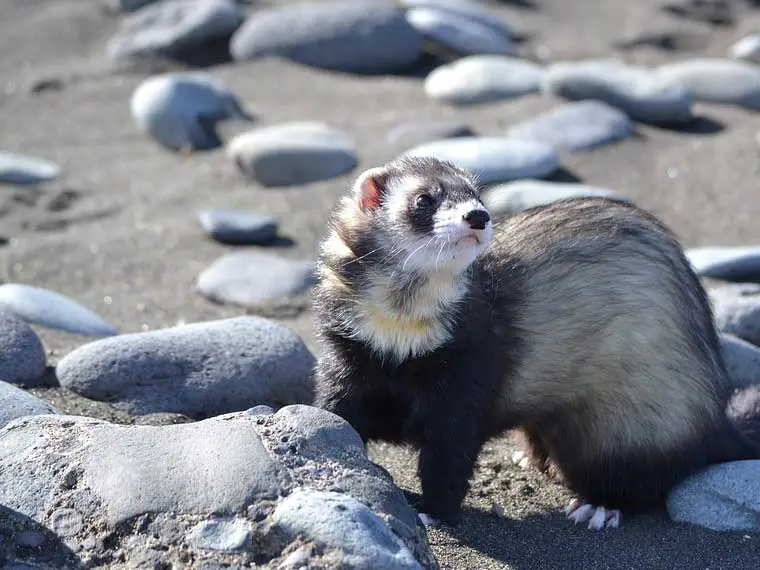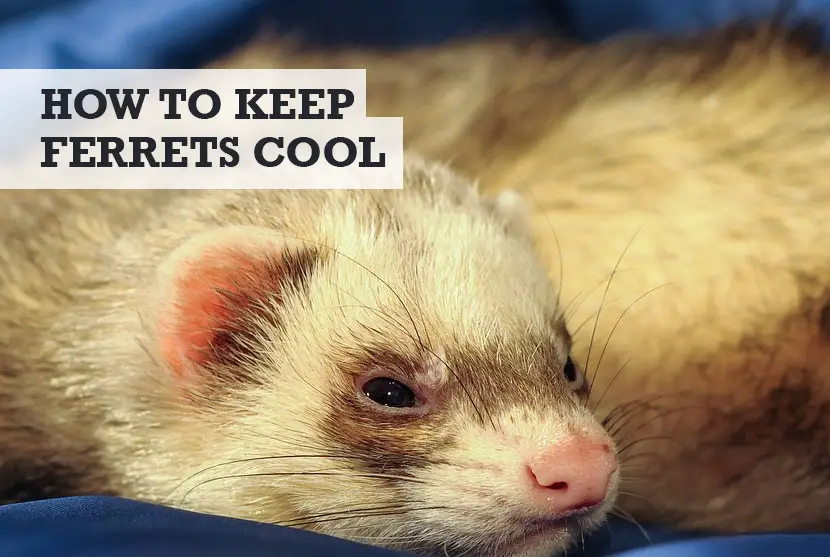Ferrets do not cope at all well with warm summers. They have few sweat glands and fur that is designed to keep their body heat in, rather than let it out.
This means that outdoor ferrets can soon overheat without adequate shade. Similarly, it might be too hot for your ferret indoors too.
Here’s a guide which explains how to know whether your ferret it too hot, and then how to keep ferrets cool in the summer.
How to keep ferrets cool in summer
Here are the ways in which I’ve kept my ferret cool in summer heat. Here’s what you can do when it gets too hot for your ferret… it’s all about taking proactive environmental measures.
I will start with tips for indoor pets, then lower down the page you can find out how to keep outdoor ferrets cool as well, plus whether ice cubes work.

1. Consider air conditioning
The most effective way of controlling the heat in your home, therefore keeping a ferret cool in summer, is to install an air conditioning system. Unfortunately, this is costly to purchase and maintain, and will incur additional costs to install. It is also not friendly to the environment.
Fortunately there are alternatives that you can use, when designing or deciding on a location in which to house your ferrets, in order to minimise the possibly of heat stress.
By effectively controlling the environmental factors, such as light, heat, air movement and humidity, you can make your hot ferret cooler and more comfortable, even during the warmest of summer days.
Prevention is better than cure, and these measures may even bring you some relief.
2. Keep the heat out
The best way to manage heat with your indoor ferret is to keep it out, i.e. by reducing the amount of sunlight that enters the room. Ferrets sleep most of the daylight hours so they do not require much sunlight for their well-being.
To help keep you ferret cool, place the cage or hutch in the coolest room in the house, which will probably be an area on the shady side of the house.
If you have an option, install small windows at head height or higher. This will allow less heat in, and warm, rising air to find a way out. Always remember to ferret proof any exit points.
If any window allows direct sunlight into their enclosure, block the sun by cultivating a screen of plants outside or installing an awning above the window. Alternatively, you can install a reflective film on the outside of the window which prevents heat radiation.
Double glazing will create an air gap in the windows, stopping the conduction of heat from the outside to the inside. A cheaper option would be to simulate this air gap by sticking bubble wrap onto the inside of the window.
It is easily applied by cutting the bubble wrap to the right size and shape, wetting it, and applying some pressure to make it stay put. It is equally easy to remove when summer is over.
Blackouts work effectively at keeping the sun and light out. There are inexpensive, paper accordion blinds available that you can cut to size, and install inside the window recess, close to the glass (view on Amazon).
Black will absorb heat so choose a lighter colour, to reflect the heat. The same principle applies to curtains.
As far as it is practical, close curtains in windows in other rooms that receive direct sunlight. If you keep the ambient temperature in the house down, it will be easier to control your ferrets’ environment.
3. Create air flow to remove the heat
Ventilation is essential for ensuring that the air in your home does not become stale and unhealthy, making your ferret too hot. Air moves from an area of high pressure to an area of low pressure. Warm air will always attempt to replace cool air, for example, heat will rise to escape a warm ground surface.
Work with the wind direction and make pathways for the air that reduce the temperature.
Open windows when the air outside is cooler, and close them when it heats up. Air vents and fanlights, situated near the roof or ceiling will provide escape routes for warm air inside the house.
Heat extractors work well, as do ceiling fans that draw the warm air upwards.
If you have flies, air movement has an added benefit. They do not like cool air or breezes.
4. Manage the humidity
The amount of moisture in the air exaggerates the way the temperature feels. This works in cold and warm weather. If the air is humid on a hot day, it will feel much hotter.
Humans and animals are constantly letting off steam when they breathe out. Moisture builds up in a closed environment, making good ventilation essential.
Make sure your ferret enclosure has no damp problems which could happen on the cool side of the house. And do not introduce water to a room that is closed up. The jury is out on whether plants cool an environment or add to the humidity. They do add cheer but be sure that they are non-toxic.
Air conditioning units have a tendency to dry the air but if you are trying to cool the area naturally, you might consider purchasing a dehumidifier.
5. Use evaporation
Refrigeration works on the principle of evaporation to cool the contents down. You can generate your own evaporation, with a damp cloth and air movement.
Place a slightly moist cloth on the windward side of the ferrets’ cage or on a screen door. This will create a cooling effect as the air moves over it.
6. Remove surfaces that retain heat
Rugs, carpets, blankets and throw pillows all retain heat and make an area feel warmer. Textile properties also make a difference, which is why alternating winter and summer curtains makes sense.
Change to light cotton or linen curtains in summer. You can also replace your ferrets’ fuzzy winter blankets and hammocks with ones made from lighter fabrics.
Handy Hint: Speaking of winter, here’s how to keep a ferret warm and when cold gets too cold.
7. Introduce cold elements
Floors that are tiled in a light colour are the best surfaces for helping your ferrets keep cool in summer. On a very warm day, you can mop the tiles with cold water to cool them even further.

Wrap bottles of ice in towels and place them at the bottom of the cage, or where your ferrets sleep. Remove the labels or these critters might do it for you. If they swallow foreign objects this could cause them intestinal blockages, and a string of vets’ bills.
As a desperate measure, you can give your ferret a tepid bath. Cold water will be a shock to the system so take the edge off it with a bit of warm water. You do not want to do this too often as it will remove the natural oils in their fur.
Some ferrets will not appreciate a bath so, unless you deem it absolutely necessary, it will not be worth the added stress for both of you.
Can ferrets have ice cubes?
Yes ferrets can have ice cubes. All you need to do is add ice cubes to your ferrets’ water bowl. If they don’t drink the water, they will play with the ices cubes and cool down anyway.
Think of ways to minimise splashing so that you, and they, do not slip on a wet floor.
How do I know if my ferret is too hot?
You will quickly know whether your ferret is too hot due to their body language. Ferrets have small bodies that react quickly to high temperatures. In no time at all, they can experience stress, lethargy and heat stroke.
There are several actions you can take to keep their environment cool enough for them to be comfortable in.
These include managing the light, temperature and humidity in their enclosures, as well as providing temporarily relief, for example, doing something as simple as adding ice cubes to their drinks.
Signs of heat stress in ferrets
When your ferret starts feeling too warm, it will look for ways to cool itself off. It may drink more than usual and start panting to reduce body heat through its mouth. It will look for a cool surface, such as a tiled floor, on which to rub its belly.
If you see these signs, it is time to take action to prevent any problems.
If the ferret is not able to cool itself, it will appear lethargic and possibly refuse food and treats. Check for signs of dehydration.
If you pull the skin behind its neck away from its body, and it does not ‘bounce’ back, your ferret could be heading for trouble.
Severe heat stress could cause breathlessness and blackouts, rendering your ferret unconscious.
You need to do what you can to bring its internal temperature down fast, like laying it next to ice blocks wrapped in towels, and get it to a vet as soon as possible.
Handy Hint: If your ferret lives outdoors make sure you tick all the boxes when it comes to considering the best ferret enclosure for them to live in.
Conclusion
It’s very worrying when a ferret overheats, so do your utmost to not get to that point. Your ferret will heat up quicker than you do, so prevention is far better than cure in hot summers.
You might also like…
- The truth about ferrets killing snakes
- How a ferret can become attached to just one person
- Signs that your ferret is way too skinny
Image in header of a ferret cooling down via https://pixabay.com/photos/ferret-putoisé-mustélidé-drowsy-3723085/



